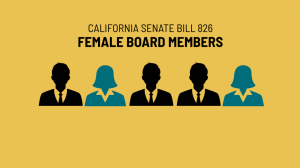CON
November 9, 2018
At surface level, SB 826 seems to be a step forward for women struggling to reach top leadership positions in companies. There are cracks, however, in this apparently progressive stride for workplace diversity.
Although it strives to combat the pressing problem of gender diversity in the workplace, SB 826 is inherently flawed. It might just be that many men are qualified for board positions in one company, while very few or no women meet such standards. But due to SB 826, the company would be required to have a woman on its board, forgoing a better candidate to abide by the law.
Mandating that companies must have a certain number of female board members would undercut the organizational structure of many businesses, including large companies like Apple, which currently only has two women on a board of eight. This could lead to less experienced boards or a lack of qualified women.
On the other hand, qualified women who are elected onto company boards may be undermined by claims that they were only chosen because of law’s requirements. Such claims would be detrimental to their careers.
Additionally, the legality of the law is rocky. According to Stanford University law professor and former Securities and Exchange commissioner Joseph Grundfest, 7 percent of companies headquartered in California are not chartered in the state. SB 826 would impact all companies headquartered in California, going against the internal affairs doctrine, which states that companies are subject to the laws of their states of incorporation, not those of the states where they are headquartered.
The equal protection clause of the U.S. Constitution, which prohibits states from denying citizens equal protection of the law, is another legal hurdle. In order for SB 826 to be recognized by the national government, California would have to prove that women are truly significantly underrepresented on boards.
Furthermore, SB 826 focuses solely on gender when there are other forms of diversity to take into consideration. The 2016 joint report by the Alliance for Board Diversity and Deloitte found that of those serving on boards of Fortune 100 companies, only 17.5 percent were minorities. To introduce true diversity to boards, factors like race and sexual orientation should also be considered.
Despite having been drafted with the right intentions, SB 826 does not completely address the lack of diversity in high-level positions at companies throughout the state. This act of legislature is not the right way to introduce needed diversity of all kinds into the workplace and fails to solve the diversity issue for California-based company boards.



























































